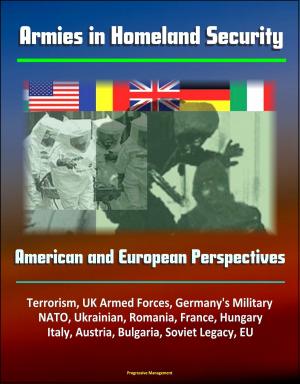Air Power and the Ground War in Vietnam: Ideas and Actions - Counterinsurgency, Air Power Theories, Secret Bombing, Supporting Ground Combat Forces, Gunships, Interservice Differences
Nonfiction, History, Military, Vietnam War, Asian, Aviation| Author: | Progressive Management | ISBN: | 9781476116181 |
| Publisher: | Progressive Management | Publication: | June 18, 2012 |
| Imprint: | Smashwords Edition | Language: | English |
| Author: | Progressive Management |
| ISBN: | 9781476116181 |
| Publisher: | Progressive Management |
| Publication: | June 18, 2012 |
| Imprint: | Smashwords Edition |
| Language: | English |
Dr. Mrozek focuses on expectations concerning the impact of airpower on the ground war. He describes some of the actual effects but avoids treatment of some of the most dramatic air actions of the war, such as the bombing of Hanoi. He observes that the application of airpower is influenced by factors far beyond the battlefield.
Ultimately, this study is about a smaller Vietnam War than that which is commonly recalled. It focuses on expectations concerning the impact of air power on the ground war and on some of its actual effects, but it avoids major treatment of some of the most dramatic air actions of the war, such as the bombing of Hanoi. To many who fought the war and believe it ought to have been conducted on a still larger scale or with fewer restraints, this study may seem almost perverse, emphasizing as it does the utility of air power in conducting the conflict as a ground war and without total exploitation of our most awe-inspiring technology.
Part one examines the way in which ideas about air power affected the thinking of many Air Force personnel about how to fight both before and during the Vietnam War, some relevant conflicts within the Air Force, the relationship between interservice differences and the arrangements made for command and control, and the tendency among both civilians and the military to fail to differentiate between war as combat and war as politics. The three chapters do more than provide historical background. They argue that the Air Force was neither neutral nor passive with respect to the conflict in Southeast Asia. These chapters also argue that Air Force ideas produced only one set of strongly advocated options for managing the war. The centers of civilian authority themselves became important actors in the war in Southeast Asia far beyond mere reaction. Problems do not exist in a vacuum, nor are their dimensions understandable in isolation.
PART ONE * EVERYBODY'S WAR, NOBODY'S WAR * 1 AIR POWER THEORIES, AIR FORCE THINKING, AND THE CONFLICT IN VIETNAM: THE PAST WAS PROLOGUE * The Thrust of US Air Power Theories * The Ascendancy of the Offensive * Limited War as a Challenge to Doctrine * Vietnam and the Burden of the Past * Notes * 2 INTERSERVICE DIFFERENCES, COMMAND AND CONTROL, AND THE CONDUCT OF WAR IN SOUTHEAST ASIA * Interservice Differences in the Post-World War II Context * The Search for Simplicity in the Complexity of Southeast Asia * Pressures for Change * Doctrine and Complexity * Notes * 3 WAR MAKING AND WAR POLITICS: CIVILIAN OFFICIALS AND THE USES OF MILITARY POWER * Political Action as a Counterguerrilla War * Competing Visions of the Vietnam War * Self-Defeating Aspects of the US Commitment to Counterinsurgency * War as Politics * The Continuation of War as Politics * Notes * PART TWO * "TWO, THREE ... MANY VIETNAMS" * 4 RETHINKING GROUND WARFARE * Mobility versus Autonomy * Firepower and Firebases * Supply, Support, and Security * "Secret" Bombing and Hidden Warfare * Half-Told Tales * Notes * 5 PROBLEMS IN THE PERFORMANCE OF TRADITIONAL ROLES * Persistence and Pride * Intelligence and Reconnaissance * Search, Rescue, and Evacuation * Supporting Ground Combat Forces * Notes * 6 THE LIMITS OF INNOVATION * Fixed-Wing Gunships: Square Pegs, Varied Holes, and the Penknife of Innovation * War and the Environment * Tactical Innovation and the B-52 * Ground Alternatives for Clearing and Interdiction * Self-Sustaining Change * Notes * PART THREE * REFLECTIONS AND CONCLUSIONS * 7 AIR POWER AND THE AMBIVALENCE OF VIETNAM * War as an Event and as a Process * Limited War and Limited Commitment * Complexity and Simplicity * Managing War and Waging Diplomacy * Between Rigidity and Vacillation * The Illusion of Neutrality * Notes
Dr. Mrozek focuses on expectations concerning the impact of airpower on the ground war. He describes some of the actual effects but avoids treatment of some of the most dramatic air actions of the war, such as the bombing of Hanoi. He observes that the application of airpower is influenced by factors far beyond the battlefield.
Ultimately, this study is about a smaller Vietnam War than that which is commonly recalled. It focuses on expectations concerning the impact of air power on the ground war and on some of its actual effects, but it avoids major treatment of some of the most dramatic air actions of the war, such as the bombing of Hanoi. To many who fought the war and believe it ought to have been conducted on a still larger scale or with fewer restraints, this study may seem almost perverse, emphasizing as it does the utility of air power in conducting the conflict as a ground war and without total exploitation of our most awe-inspiring technology.
Part one examines the way in which ideas about air power affected the thinking of many Air Force personnel about how to fight both before and during the Vietnam War, some relevant conflicts within the Air Force, the relationship between interservice differences and the arrangements made for command and control, and the tendency among both civilians and the military to fail to differentiate between war as combat and war as politics. The three chapters do more than provide historical background. They argue that the Air Force was neither neutral nor passive with respect to the conflict in Southeast Asia. These chapters also argue that Air Force ideas produced only one set of strongly advocated options for managing the war. The centers of civilian authority themselves became important actors in the war in Southeast Asia far beyond mere reaction. Problems do not exist in a vacuum, nor are their dimensions understandable in isolation.
PART ONE * EVERYBODY'S WAR, NOBODY'S WAR * 1 AIR POWER THEORIES, AIR FORCE THINKING, AND THE CONFLICT IN VIETNAM: THE PAST WAS PROLOGUE * The Thrust of US Air Power Theories * The Ascendancy of the Offensive * Limited War as a Challenge to Doctrine * Vietnam and the Burden of the Past * Notes * 2 INTERSERVICE DIFFERENCES, COMMAND AND CONTROL, AND THE CONDUCT OF WAR IN SOUTHEAST ASIA * Interservice Differences in the Post-World War II Context * The Search for Simplicity in the Complexity of Southeast Asia * Pressures for Change * Doctrine and Complexity * Notes * 3 WAR MAKING AND WAR POLITICS: CIVILIAN OFFICIALS AND THE USES OF MILITARY POWER * Political Action as a Counterguerrilla War * Competing Visions of the Vietnam War * Self-Defeating Aspects of the US Commitment to Counterinsurgency * War as Politics * The Continuation of War as Politics * Notes * PART TWO * "TWO, THREE ... MANY VIETNAMS" * 4 RETHINKING GROUND WARFARE * Mobility versus Autonomy * Firepower and Firebases * Supply, Support, and Security * "Secret" Bombing and Hidden Warfare * Half-Told Tales * Notes * 5 PROBLEMS IN THE PERFORMANCE OF TRADITIONAL ROLES * Persistence and Pride * Intelligence and Reconnaissance * Search, Rescue, and Evacuation * Supporting Ground Combat Forces * Notes * 6 THE LIMITS OF INNOVATION * Fixed-Wing Gunships: Square Pegs, Varied Holes, and the Penknife of Innovation * War and the Environment * Tactical Innovation and the B-52 * Ground Alternatives for Clearing and Interdiction * Self-Sustaining Change * Notes * PART THREE * REFLECTIONS AND CONCLUSIONS * 7 AIR POWER AND THE AMBIVALENCE OF VIETNAM * War as an Event and as a Process * Limited War and Limited Commitment * Complexity and Simplicity * Managing War and Waging Diplomacy * Between Rigidity and Vacillation * The Illusion of Neutrality * Notes















